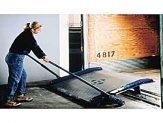 Dock boards are simple ramps, usually made of metal, that bridge the gap between a loading dock surface and a truck that has pulled up to it. Because trucks come in various sizes, the size and height of this gap is variable. Consequently, a dock board has to be large enough to bridge this gap and strong enough to support whatever is being rolled across its surface.
Dock boards are simple ramps, usually made of metal, that bridge the gap between a loading dock surface and a truck that has pulled up to it. Because trucks come in various sizes, the size and height of this gap is variable. Consequently, a dock board has to be large enough to bridge this gap and strong enough to support whatever is being rolled across its surface.
Dock boards are typically made of steel and are used to support heavier loads, such as forklifts, power jacks and other materials handling motorized vehicles. In contrast, lighter weight dock plates usually are made of aluminum and are graded to support lighter loads, such as handcarts and dollies.
Dock Boards vs. Dock Levelers
Neither dock boards nor dock plates are permanently attached to the dock and are instead moved into place when needed either by use of machinery such as a forklift, by a mechanical device such as a dock board lifter, or by hand.
Dock levelers and lifts are permanent fixtures that are secured to the door of a dock. They often include hydraulic motors that allow the dock leveler to be fitted into the space between the dock and the truck automatically.
Selecting the Best Dock Board for the Job
When purchasing a dock board, the first thing to consider is the length and width that you will need. To determine the length, measure the dock height, the height of the largest truck that typically will use that dock, and the type and capacity of the loading equipment that is going to be used to load and unload trucks at that dock.
Most commercial dock boards come in two standard sizes of 35″and 48″, but larger and small ones also are available. Choose one that is a minimum of 12″ wider the width of the vehicle or pallet used during loading.
To calculate the proper height differential, subtract the maximum height of most trailers (55″) from the height of your dock. If your dock uses a lot of refrigerated or container trailers, the maximum height should be increased to 59″.
Determining Maximum Weight Capacity
The next thing to determine is the weight capacity of the dock board. To calculate this, determine the maximum weight of whatever vehicle you will be using during loading and add to that the maximum weight of the load to be transported. If you are using paper roll clamp and multi-shift loading, add another 5,000 pounds to the dock board’s maximum capacity.
Dock boards will be rated according to their maximum capacity for a single-shift operation at a 3 mile per hour maximum rate of travel.
Accessories and Options
Some dock boards come equipped with an easy-roll device that makes it easy for workers to position them into place without theuse of a forklift. These have wheels and telescoping, self-storing handles that make them easy to roll into and out of position.
Dock board accessories include lifting chains, which are used to attach the dock board to a forklift so that it can easily be maneuvered into place as well as removed later.
